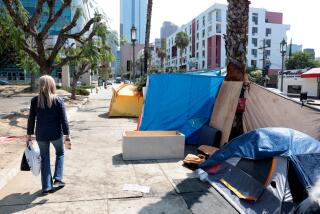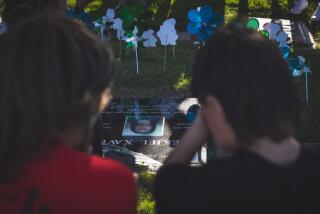No Easy Answers to Help Drug Babies
Cindy Boyd is sitting on the couch, leaning forward, elbows on her knees, trying to make a point through the barrier of a different world. The beautiful people of the television soap opera, their voices lowered with volume control, seem to be looking on.
“I was taking methamphetamine,” she says. “I was doing like mega amounts, to the point that I wanted an abortion, but I was too far along. Then when I got out of jail, I got high three times. It’s real sick. You’re still an addict. It’s there. I was having a hard time.
“It was an ‘I’ll show him’--the baby’s father--kind of thing. And plus, when I was pregnant, I felt so big, like I could hardly move. When I would use, it was like I could get up and dance the jig.”
Cindy’s baby, Kayla, was born on Sept. 24, 1989. The staff at Martin Luther Hospital in Anaheim wouldn’t allow Cindy to take her home. A county social worker was called. The baby had tested positive for drugs.
Hospital personnel noticed the needle tracts on Cindy’s arms when she arrived to give birth. She was severely bruised, too, black and blue from her neck down to around where her stomach bulged.
Cindy tells me that she had been beaten, a lot. Her eyes open a little wider, the cigarette between her fingers stills. Then she shrugs.
“When you’re using, you don’t call the police,” she says. “They’ll arrest you too.”
Kayla is here with us now, asleep after a bottle, next to Cindy on the couch. Cindy calls her perfect, and from where I sit, that looks about right.
She is chubby, with blond curly hair and blue eyes. She’d given me a shy wave earlier, then come over and stared at me, breaking into a big smile.
Both Cindy and Kayla are lucky to be alive.
Cindy, who suffers from heart disease, has a pacemaker implanted in her chest. The latest count: 45 surgeries designed to prolong her life. She is 33 years old.
Welfare, now, is how she and Kayla survive. Cindy says she sold drugs before. She’s served felony time.
Cindy says that she has gone straight--18 months so far--and that she doesn’t even allow users into her home. The county gave her baby back after holding her a month; by then Cindy had arranged for a place to live with friends. She still sees the baby’s father, but they don’t live together anymore.
Cindy says she’s hoping to learn a trade soon. Data processing, or something with computers, is one idea.
Kayla, cared for by pediatricians at the Hope Clinic, part of UCI Medical Center’s program for drug-exposed kids, hasn’t shown any major signs of distress. Doctors there caution, however, that problems might not appear until she is 5 years old.
“One of the real strange, sick thoughts I would have when I was sticking the needle in me when I was pregnant was that I was sticking a needle in an infant’s arm,” Cindy says. “It’s a real hard thing to explain to someone who is not addicted. It’s a real strange, hard thing. Because I love children so much.”
Common sense does not apply here.
Cindy Boyd, the mother of three other children living with her ex-husband, tells me that even though she understood what she was doing to her unborn child, and herself, that didn’t translate into trying to turn her life around.
Not then, at least, not when it counted most. She says she had no idea how.
And besides, Cindy says that she did not want any help. A few people suggested that it might be a good idea. But Cindy just wanted drugs.
A study released here last week estimates that about 2% of the 4,000 babies born each month in Orange County have illicit drugs in their blood--or about 80 a month. The study’s authors, however, say that estimate might be low. The latest national survey, conducted at 36 hospitals in 1988, estimates about 375,000 pregnant women were using drugs shortly before they gave birth.
Most of these drug-exposed children, the experts say, will carry the burden of their mother’s addiction for years. They will have trouble learning, trouble controlling emotional ups and downs, trouble doing most of what people consider coping with normal life.
Nobody can really say how long the handicaps will last. The whole sad phenomenon is too new to fit into a neat scientific graph.
And these numbers do not include the babies who have died from drugs. Coroner’s records show that last year in Orange County, drugs carried through the placenta killed 11 here. It’s too early to tell what the number will be this year.
There’s no good answer, or at least nothing that I really like, to the question of what should be done.
We live in a country where individual freedom is prized, yet one where the understanding seems to be that everyone should be helped, for their own good . Children, most people believe, are high up on the list.
But does that really mean we should call out the pregnancy police?
“Education” is the fuzzy, catchall answer offered by people of good will and earnest, measured thoughts. Sometimes education even works.
More radical responses--Norplant is one--are being heard more and more, the fruit of frustration because sometimes just isn’t good enough.
“I come from--what’s the word?--a dysfunctional family,” Cindy Boyd says, “and it is carried on. Addicts tend to have addicts.”
Cindy has picked up the jargon of the groups--Alcoholics Anonymous, Cocaine Anonymous, Narcotics Anonymous--that have helped her. They are no longer just groups, of course, but gatherings of friends.
Cindy says it is fun being clean and that motherhood is great, but she doesn’t have much faith that other addicts will follow her path.
“I know women who have had numerous babies born addicted and they just let them go to the state or a relative, or they keep them so that they can get welfare,” she says.
“I feel that the courts should make these women use some kind of birth control, and if they don’t, they should be fixed because it’s the children who are going to suffer.”
Cindy Boyd calls this a “weird perspective.” Perhaps. But it comes with views from both sides.
More to Read
The complete guide to home viewing
Get Screen Gab for everything about the TV shows and streaming movies everyone’s talking about.
You may occasionally receive promotional content from the Los Angeles Times.






